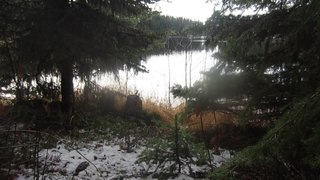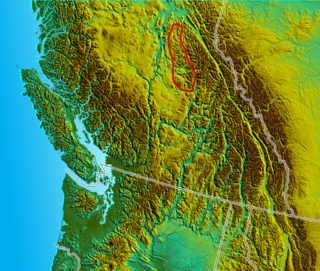Related Research Articles
Murphy Orlando Shewchuk is a Canadian writer. He is a past National President of the Canadian Authors Association. He currently resides in Merritt, BC.

The Okanagan, also known as the Okanagan Valley and sometimes as the Okanagan Country, is a region in the Canadian province of British Columbia defined by the basin of Okanagan Lake and the Canadian portion of the Okanagan River. It is part of the Okanagan Country, extending into the United States as Okanogan County in north-central Washington. According to the 2016 Canadian census, the region's population is 362,258. The largest populated cities are Kelowna, Penticton, Vernon, and West Kelowna.
Tkʼemlúps te Secwépemc, abbreviated TteS and previously known as the Kamloops Indian Band, is a First Nations government within the Shuswap Nation Tribal Council, which represents ten of the seventeen Secwepemc band governments, all in the southern Central Interior region, spanning the Thompson and Shuswap districts. It is one of the largest of the 17 groups into which the Secwepemc (Shuswap) nation was divided when the Colony of British Columbia established an Indian reserve system in the 1860s.
The Nicola people are a First Nations political and cultural alliance in the Nicola Country region of the Southern Interior of the Canadian province of British Columbia. They are mostly located in the Nicola River valley around the area of Merritt and are an alliance of Scw'exmx, the local branch of the Nlaka'pamux (Thompson) people, and the Spaxomin, the local branch of the Syilx or Okanagan people. The combined population of the communities composing the Nicola people is approximately 3,492, with around 1,250 of these members living on-reservation.
Porcupine Meadows Provincial Park is a 2,704 hectare provincial park in British Columbia, Canada, located north of Tranquille Lake to the northwest of Kamloops. Its name is a direct translation of the Shuswap word for this area, "pisitsoolsia", named so for the numerous porcupine in the area.
Nicola Lake is a glacially formed narrow, deep lake located in the South-Central Interior of British Columbia, Canada approximately thirty kilometres northeast of the city of Merritt. It was a centrepoint of the first settlements in the grasslands lying south of Kamloops, and today is used for recreation and as a water storage site to provide irrigation and water flows to fisheries downstream in the Nicola River. The lake is important in the history of the local Nicola people as the location of one of their major communities, Nicola Lake Indian Reserve No. 1, which lies on its eastern shore and is the home of the Upper Nicola Indian Band. Many of the band work for the Douglas Lake Cattle Company, aka the Douglas Lake Ranch, whose headquarters are also adjacent to the lake.

The Douglas Lake Cattle Company is Canada's largest working cattle ranch, usually known as the Douglas Lake Ranch. Founded June 30, 1886, it has been operating continuously since. This date also marks the completion of the last leg of the first transcontinental rail line of the Canadian Pacific Railway from Montreal to Vancouver.

The Okanagan Highland is an elevated hilly plateau area in British Columbia, Canada, and the U.S. state of Washington. Rounded mountains with elevations up to 8,000 ft (2,400 m) above sea level and deep, narrow valleys are characteristic of the region.

The Thompson Plateau forms the southern portion of the Interior Plateau of British Columbia, Canada, lying to the west of Okanagan Lake, south of the Thompson River and east of the Fraser River. At its most southern point the plateau is squeezed by the mountainous terrain of the Cascade Range abutting closer to the Okanagan Valley. Its southwestern edge abuts the Canadian Cascades portion of that extensive range, more or less following the line of the Similkameen River, its tributary the Tulameen River, and a series of passes from the area of Tulameen, British Columbia to the confluence of the Thompson River with the Nicoamen River, a few kilometres (miles) east of Lytton, British Columbia, which is in the Fraser Canyon. Its northeastern edge runs approximately from the city of Vernon, British Columbia through the valley of Monte Creek to the junction of the same name just east of the city of Kamloops. Northeast of that line is the Shuswap Highland.
Nicola, also Nkwala or N'kwala, was an important First Nations political figure in the fur trade era of the British Columbia Interior as well as into the colonial period (1858–1871). He was grand chief of the Okanagan people and chief of the Nicola Valley peoples, an alliance of Nlaka'pamux and Okanagans and the surviving Nicola Athapaskans, and also of the Kamloops Band of the Shuswap people.

The Nicola River, originally French Rivière de Nicholas or Rivière de Nicolas, adapted to Nicolas River, Nicola's River in English, is one of the major tributaries of the Thompson River in the Canadian province of British Columbia, entering the latter at the town of Spences Bridge. It is named for Nicola (Hwistesmexteqen) the most famous chief of the joint community of Nlaka'pamux and Okanagan bands, founded by his father and today known as the Nicolas,, as well as its basin, which is known as the Nicola Country. It drains most of the northern Thompson Plateau, beginning near the very eastern edge of the plateau only 30 kilometres (19 mi) northwest of Kelowna, and flows from there more or less westward to feed Douglas Lake and Nicola Lake, with about 15 kilometres (9 mi) of the river's length between those two lakes. Nicola Lake at 20 kilometres (12 mi) long is the largest in the basin; the Nicola River enters at 3/4 way of its length up from its outlet, 10 kilometres (6 mi) downstream from which is Nicola Valley centre and Coquihalla Highway city of Merritt. From there the river flows 60 kilometres (37 mi) northwest to the Thompson, and is followed on that route by British Columbia Highway 8 and a spur line of the Canadian Pacific Railway.

The British Columbia Interior, popularly referred to as the BC Interior or simply the Interior, is a geographic region of the Canadian province of British Columbia. While the exact boundaries are variously defined, the British Columbia Interior is generally defined to include the 14 regional districts that do not have coastline along the Pacific Ocean or Salish Sea, and are not part of the Lower Mainland. Other boundaries may exclude parts of or even entire regional districts, or expand the definition to include the regional districts of Fraser Valley, Squamish–Lillooet, and Kitimat–Stikine.

The Quesnel Highland is a geographic area in the Central Interior of the Canadian province of British Columbia. As defined by BC government geographer in Landforms of British Columbia, an account and analysis of British Columbia geography that is often cited as authoritative, the Highland is a complex of upland hill and plateau areas forming and defined as being the buffer between the Cariboo Plateau and the Cariboo Mountains, as a sort of highland foothills along the eastern edge of the Interior Plateau running southeast from a certain point southeast of the city of Prince George to the Mahood Lake area at the southeast corner of the Cariboo. Beyond Mahood Lake lies another separately classified area dubbed by Holland the Shuswap Highland which spans similar terrain across the North Thompson and Shuswap Lake-Adams River drainage basins, forming a similar upland-area buffer between the Thompson Plateau and the Monashee Mountains. A third area, the Okanagan Highland, extends from the southern end of the Shuswap Highland in the area of Vernon and Enderby in the northern Okanagan region into Washington State, and also abuts the Monashee Mountains.

The Shuswap Highland is a plateau-like hilly area of 14,511 km2 (5,603 sq mi) in British Columbia, Canada. It spans the upland area between the Bonaparte and Thompson Plateaus from the area of Mahood Lake, at the southeast corner of the Cariboo Plateau, southeast towards the lower Shuswap River east of Vernon in the Okanagan.
The Nicola Athapaskans, also known as the Nicola people or Stuwix, were an Athabascan people who migrated into the Nicola Country of what is now the Southern Interior of British Columbia from the north a few centuries ago but were slowly reduced in number by constant raiding from peoples from outside the valley, with the survivors, the last of whom lived near Nicola Lake, assimilated to the Scw'exmx-Syilx Nicola people by the end of the 19th century. The term Nicola for them is a misnomer, though a common one used by ethnologists and linguists - it commemorates a famous Okanagan chief who once held sway over the valley and its peoples as well as over the Kamloops Shuswap).

The Okanagan Country, also known as the Okanagan Valley, is a region located in the Canadian province of British Columbia and the U.S. state of Washington, defined by the basin of Okanagan Lake and the Okanagan River. With an estimated 400,000 residents, the Okanagan Country spans from the Thompson Plateau near Grindrod, British Columbia in the Okanagan to the Okanagan Highland near Douglas County, Washington in the Okanogan. The largest city in the Canadian portion is Kelowna, with a metropolitan population of 194,882 residents as of 2016, while the largest city in the American portion is Omak, with 4,881 residents as of 2011. The region took its current name in honor of the Okanagan term, ukʷnaqín. The mild climate and close proximity to lakes, rivers and mountainous regions make the Okanagan Country an outdoor recreational destination. The region's economy is dominated by the primary sector industries of agriculture and forestry, although economic diversification has also occurred with retirement communities and recreational tourism. The American portion is considered to be more remote than the Canadian division, with approximately 10 percent of the population.

The Shuswap Country, or simply the Shuswap and called Secwepemcúl̓ecw in Secwepemctsín, is a term used in the Canadian province of British Columbia to refer to the environs of Shuswap Lake. The upper reaches of the Shuswap basin, southeast of Shuswap Lake and northeast of the Okanagan, are generally considered to be part of Okanagan or of the Monashee Country rather than "the Shuswap". Roughly defined, the Shuswap Country begins on its west at the town of Chase, located on Little Shuswap Lake, west of which is the South Thompson area of the Thompson Country, and includes Adams Lake to the northwest of Shuswap Lake as well as communities in the Eagle River area as far as Craigellachie and/or Three Valley Gap, which is at the summit of Eagle Pass, beyond which eastwards is the Columbia Country.

The Deadman River, also known as the Deadman's River, Deadman Creek or Deadman's Creek, is a tributary of the Thompson River in the British Columbia Interior of British Columbia, Canada. It is about 70 kilometres (43 mi) in length.

Thompson Country, also referred to as The Thompson and sometimes as the Thompson Valley and historically known as the Couteau Country or Couteau District, is a historic geographic region of the Southern Interior of British Columbia, more or less defined by the basin of the Thompson River. This is a tributary of the Fraser; the major city in the area is Kamloops.